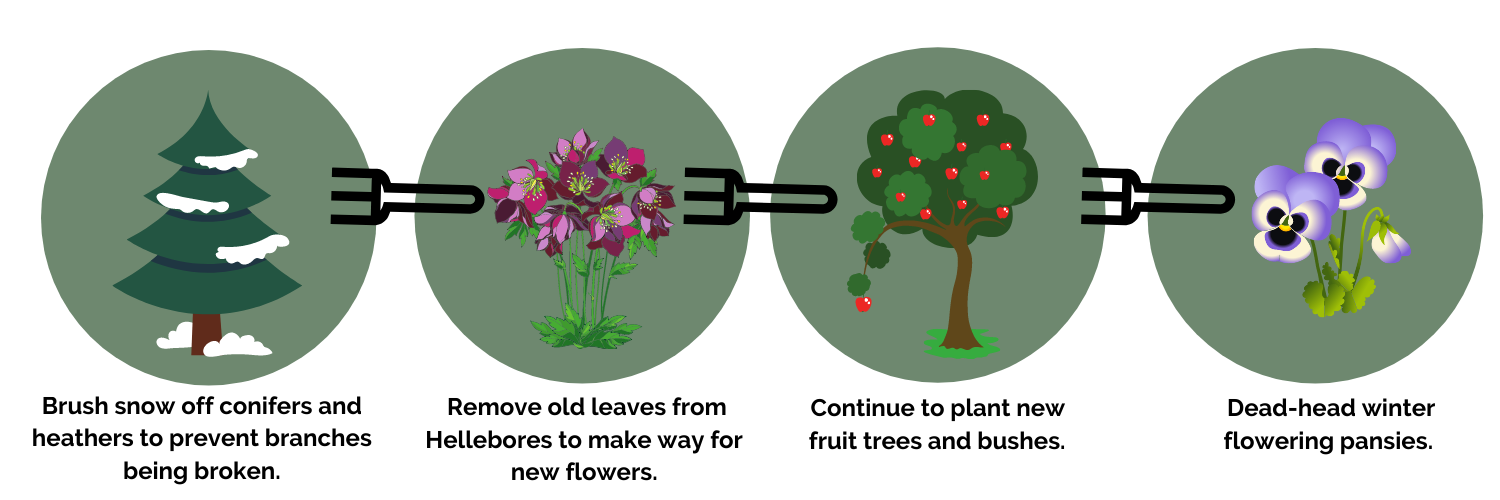
Another year has been and gone and with another lockdown just announced there's plenty of jobs you can be doing in the garden this month.
Check out our January garden reminders put together by horticulturalist and Chairman, John Richardson.
1) In rock gardens and raised beds to ensure that fallen leaves have been removed in order to prevent Botrytis as they rot down.
2) Brush snow off conifers and heathers if there is heavy snowfall, in order to prevent branches being broken.
3) Plant some lilies in deep pots and keep in the greenhouse ready for transfer to the flower border when the flowers develop.
4) Make sure the hellebores have been tidied up with the removal of all the old leaves to make way for the new flowers, which will arise very shortly.
5) When the weather is too cold to do much else, turn the compost heap sides to middle and top to bottom in order to ensure the compost is evenly rotted down.
6) Continue to plant new fruit trees and bushes when conditions allow and apply a 12cm thick mulch of well-rotted compost to the root zone, allowing a 10cm space between compost and the trunk or stems to prevent future stem rot.

7) Take root cuttings of a wide range of plant species by lifting the root system and selecting a few roots the thickness of a little finger and 8-10cm long. Cut the top horizontal and the base diagonal to prevent confusion. Plant in the compost a couple of cms. below the surface and cover with approx. 2cm of sharp sand. Place in a cold frame or frost-free glasshouse for the rest pf the winter. New shoots should begin to appear in early spring.
8) Spray fruit trees and bushes with a tar-oil winter wash to kill overwintered aphid eggs. Do not spray in frosty or windy weather and protect evergreens or lawns in the area as they are subject to being burned by the spray. It will also kill moss and lichen.
9) Prune wisterias, cutting back all but required extension shoots. The reason for the 2-stage pruning is to concentrate nutrients in the shoots to aid the formation of flower buds.
10) Mid-winter is the best time to take chrysanthemum cuttings as they root easily.
11) Prune established fruit trees other than damsons and cherries. Prune newly planted fruit trees to shape and reduce leading shoots by half.
12) Dead-head winter flowering pansies to ensure they continue to flower freely.

13) If you need to move a shrub which has outgrown its space, dig around the plant with a vertical spade to a depth of 45-60cm and then use the spade to cut under the roots from all sides until the rootball is free. Ease a piece of thick polythene under the root system and drag it out of the hole, to its new location. Once firmly in place, fill backspace around the rootball, firm the soil by treading it in, and water thoroughly to eliminate air pockets.
14) Prune out old fruiting canes on autumn fruiting raspberries down to soil level. Remove a quarter of the old branches to the base to encourage strong new growth.
15) Before you start clearing leaves or forking over bare areas check for bulbs which have started growing and are just below the surface.
16) Check the plant labels on plants around the garden, many will have faded or broken.
17)Now the garden is bare, take an objective look around from all angles and consider if an ornament, seating or a structure of some sort would add to the interest.
18) If hard weather is forecast, wrap up tender plants such as Agapanthus in bracken or straw for added protection.
19) Mark areas in which bulbs come into flower with twigs so that future cultivations can be made safely. They will be easier to find if you wish to move them at a later date.
Click here to view other hints and tips for the rest of the year
Posted 5th Jan 9:34am